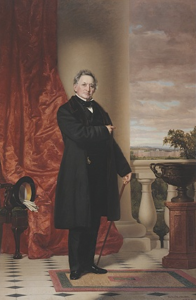Today’s post comes from Lydia Wood, class of 2017 and Art Center Summer Pindyck Intern.
This spring the Environmental Studies and American Studies programs offered a course called From the Natural History Museum to Ecotourism: The Collection of Nature. Taught by anthropology professor Anne Pike-Tay and artist Mark Dion, the class was half museum studies and half Vassar history. I chose to take this class because of my interest in museum studies and because I’ve adored every class I’ve taken with Professor Pike-Tay. The class ended up being the best thing I’ve ever taken at Vassar and really helped me think about what I want to do with my future.
Each class was centered around a few readings each week, some were more theoretical like Sally Price’s Primitive Art in Civilized Places and some were case studies such as James Clifford’s “Four Northwest Coast Museums: Travel Reflections.” Starting from the readings the class discussion covered everything from exotic pets to art museum architecture to graveyard picnics. The discussions brought in each student’s different academic background. In addition to anthropology majors the class had art history, political science, biology and religion majors, all of whom brought diverse perspectives to the material and widened our discussions inside and outside of the classroom.
As a class we took trips to the American Natural History Museum and the Tanya Bonakdar Gallery in New York City with Mark as well as several field trips within campus. We got a tour of Main Building basement from Jeff Horst and a tour of the Warthin Museum from Rick Jones. These field trips were designed to get us thinking about Mark Dion’s installation in the Frances Lehman Loeb Art Center.
As a class we helped Mark come up with ideas for the cabinet and pick objects to populate it. Mark called us his spies and sent us out to find interesting objects in our departments and dorms and anywhere else on campus we could go. This resulted in vintage board games from the Cushing Parlor, silverware from Alumnae house, fencing handles from the athletics department, and math models from Rocky. One day we were set lose in teams to search the collections in Olmstead and the Bridge building looking for science related objects for the cabinet. I was on the plant team and we worked with biology professor Mark Schlessman to select artifacts for the cabinet. We worked with the Vassar College Artifact Project collections and the Art Center’s own collection as well. Because of our diverse class we were able to reach out to other departments and arrange to borrow all kinds of things for the exhibit, making the cabinet a more inclusive picture of Vassar’s history.
When it came to installing the piece we were also very involved. Students helped gather things from all across campus and bring them to the Art Center. We carried taxidermied birds and dress forms and boxes from Archives and Special Collections all across campus. Once everything was laid out on the table in a large classroom in the Art Center we got to help arrange and install each shelf.
During study week and exam week Mark was in the Art Center with the curators and some students putting together the work. We would lay out the bigger shelves on the floor before carrying the objects downstairs and then sending them up on the lift. As the days went by the cabinet filled up with these little pieces to create a huge image of Vassar. And we saw all the pieces that never made it in, like the brain model or the crawfish life cycle display that I sat next to for the first half of my summer internship.
I am so grateful for this opportunity and I know that the rest of the class members are too. We got to be a part of an exhibit and work with a fantastic artist, all the while learning about Vassar’s history and about the history of collection and museums. I learned so many small anecdotes about Vassar through researching and cataloging these objects this summer and my appreciation for the history of our college has only grown.
This time-lapse video shows the process of setting up the installation, from the removal of the portrait of Matthew Vassar that usually occupies this space to the finished product.




